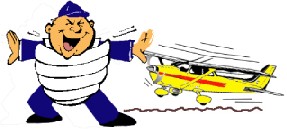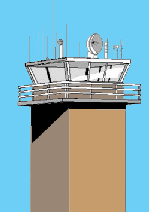 |
||||||||
| Issue Number 283 |
April
2003
|
|||||||
|
P.O. Box 189, Moffett Field, CA 94035-0189 |
||||||||
|
|
||||||||
 |
||||||||
| Issue Number 283 |
April
2003
|
|||||||
|
P.O. Box 189, Moffett Field, CA 94035-0189 |
||||||||
|
|
||||||||
Spring Training: Eliminating Fuel Errors
There
are three basic principles of proper fuel management. The first is knowing
the aircraft fuel system; second is preflight planning; third is monitoring
of actual fuel consumption. Pilots who miss the basics may not make
it all the way home.
Field of Dreams: If You Plow It, They Will Come
 By
including fuel quantity in a periodic scan of the aircraft instruments,
an abnormal trend in fuel consumption can be noted and range calculations
adjusted accordingly. This pilot did not recognize the signs, tried
to change the game plan, and wound up out in left field.
By
including fuel quantity in a periodic scan of the aircraft instruments,
an abnormal trend in fuel consumption can be noted and range calculations
adjusted accordingly. This pilot did not recognize the signs, tried
to change the game plan, and wound up out in left field.
There
was no indication of fuel leakage.... Normal fuel burn prior to
the overhaul...provided a duration of approximately four hours.
On this flight, the fuel was exhausted at approximately two hours
and thirty minutes.
Given the burn
rate experienced during the first hour of flight, two hours and thirty
minutes would have been a reasonable estimate for planning the off-airport
landing.
"This Is Like Déjà vu...
When the actual
fuel burn differs from the planned burn rate, range and endurance estimates
must be revised accordingly. In this report, another pilot didn't have
enough fuel to make it over the fence.
... All Over Again" —Yogi Berra
The pilot who
submitted this report lost his cap and then joined the rest of the team...
out in the field.
Advancing on a Good Hop
In this report,
engine overhaul was once again a factor in a fuel starvation incident.
A lucky bounce in the infield saved the day.
Fuel quantity,
burn rate, and tank selection should be monitored closely throughout
the entire flight.
AD — Attention Deficit
Fuel errors
happen, even in the majors. A few change-ups disrupted this B757 crew's
attention to fuel monitoring.
Meanwhile... in the Bleachers
As if they didn't
have enough to do keeping the passengers contented, safe and secure,
the Cabin Attendants on this flight also discovered an unusual fuel
problem (L)Avgas.
From
the Broadcaster's Booth
The controller who submitted
this report to ASRS got behind the count and learned that some situations
require help from the bench.
 Cardinal
into position... The last time I saw the Cub he...was doing a 360
[degree
turn] to allow the jet to land. I was distracted watching for the
jet to clear. When I turned around to check for the Cub and to clear
the Cardinal for takeoff, I spotted the Cub about to touchdown. I
didn't issue
a go around because
I felt it would have been more dangerous than allowing the Cub to
land.
The Cub stopped over 100 feet behind the Cardinal, then cleared the
runway.
The Cub pilot said he saw the Cardinal sitting on the runway, but
knew he could land and stop soon enough. In hindsight, I would not
have put the Cardinal into position at the intersection after the
jet landed... Also, I should have instructed the Cub to continue doing
360's on the downwind until this situation
with the jet ended. Valuable lessons were learned. Don't try to do
too many things while an emergency can distract your attention from
the operation. Also, I should have requested assistance from
other controllers [who were] on break. More eyes and ears help keep
things safer.
Cardinal
into position... The last time I saw the Cub he...was doing a 360
[degree
turn] to allow the jet to land. I was distracted watching for the
jet to clear. When I turned around to check for the Cub and to clear
the Cardinal for takeoff, I spotted the Cub about to touchdown. I
didn't issue
a go around because
I felt it would have been more dangerous than allowing the Cub to
land.
The Cub stopped over 100 feet behind the Cardinal, then cleared the
runway.
The Cub pilot said he saw the Cardinal sitting on the runway, but
knew he could land and stop soon enough. In hindsight, I would not
have put the Cardinal into position at the intersection after the
jet landed... Also, I should have instructed the Cub to continue doing
360's on the downwind until this situation
with the jet ended. Valuable lessons were learned. Don't try to do
too many things while an emergency can distract your attention from
the operation. Also, I should have requested assistance from
other controllers [who were] on break. More eyes and ears help keep
things safer. Oops! Our Error
A loyal fan submitted this report to ASRS when he noticed a disorienting change in the Callback layout.
Replacement of a faulty gyro at the printer has corrected the back page unusual attitude problem.
|
ASRS
Recently Issued Alerts On...
|
|---|
| Bell 407 rotor mast crack |
| A300 tail vibration incident |
| Falcon 20 unlatched engine cowlings |
| Wake turbulence incident at a southern airport |
| Runway signage confusion at an eastern airport |
|
March
2003 Report Intake
|
|
|---|---|
| Air Carrier/Air Taxi Pilots |
1,945
|
| General Aviation Pilots |
765
|
| Controllers |
51
|
| Cabin/Mechanics/Military/Other |
128
|
| TOTAL |
2,889
|